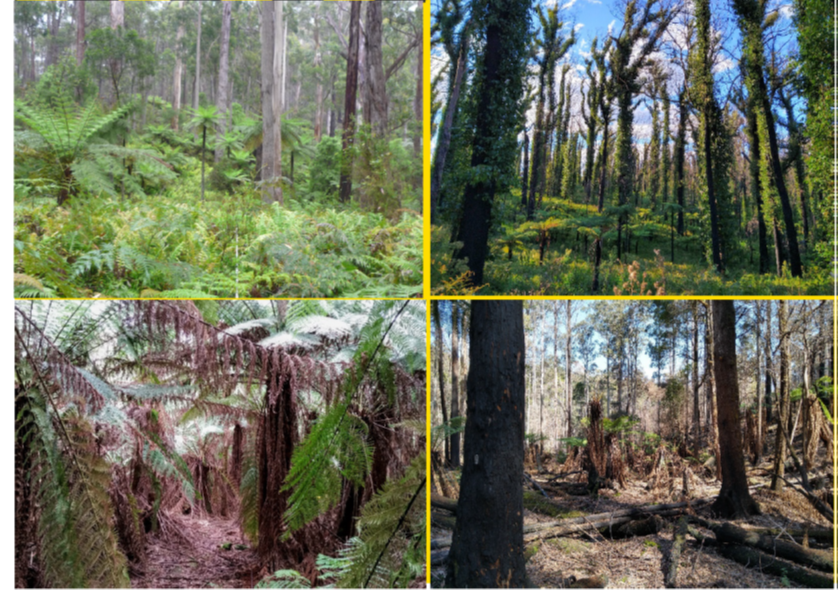
PUBLICATIONS
Published works

Understanding post-fire fuel dynamics using burnt permanent forest plots
| Title | Understanding post-fire fuel dynamics using burnt permanent forest plots |
| Publication Type | Report |
| Year of Publication | 2021 |
| Authors | Furlaud, JM, Bowman, D |
| Document Number | 674 |
| Date Published | 06/2021 |
| Institution | Bushfire and Natural Hazards CRC |
| City | MELBOURNE |
| Report Number | 674 |
| Keywords | burnt, dynamics, forest, fuel, permanent, plots, post-fire |
| Abstract | The main goal of this study is to obtain empirical measurements of fuel load, structure and hazard within the first two years after a fire to complement the measurements of fuel loads taken directly before the fires. This will not only allow us to precisely quantify the fuel loads consumed by a range of fires, but it will also give us a baseline measurement of fuel loads. We can use this baseline to anchor measurements of fuel accumulation in wet eucalypt forests that are part of related TERN and BNHCRC studies attempting to measure both the effects of climate and stand age on fuel accumulation in wet forests. Current state of knowledge The flammability of tall wet eucalypt forests is poorly understood. A globally unique forest type, these forests consist of a highly-flammable Eucalyptus overstorey and a moist, non-flammable understorey consisting of rainforest and broadleadf trees and shrubs. As a result, these forests are rarely available to burn, and almost no data exists on flammability and fire behaviour. While current fire behaviour models assume that fuel load and hence flammability increase asymptotically as a function of time since previous fire, there is much debate over whether this is the true trajectory of flammability in these forests. Understanding how fire severity is influenced by fuels and time since fire is a critical question in these forests. As the rate of spread and intensity of a fire is a function of fuels, fire weather and topography, and as only the latter can be physically manipulated, the effect of fuel load and structure on fire behaviour, and the subsequent reduction in fuels, is extremely important to understand. Planned burning, the intentional use of low-severity fire, is the most commonly employed fuel reduction technique in Australia. The underlying concept is that burning off fuel loads across a landscape leads to an increased encounter rate with low fuel load areas.7 While reducing fuel ages has been shown to reduce both the extent and incidence of unplanned fires, the effect of low severity fires on actual fuel loads has not been explicitly quantified, especially in wet forests where planned burning is less commonly practiced than in dry forest. Further, low-severity fires have historically been overlooked in wet forests, as high-severity fires are though to be the important disturbance type due to the serotinous nature of many eucalypts. But recent research indicates that low-severity fires could play a more important role that previously realised. Related projects This study is building a large dataset of pre- and post-fire permanent plot measurements to complement existing studies on the fire regime of wet eucalypt forests. As mentioned above it utilised infrastructure set up as part of the TERN forests Ausplots network, and the Warra Chronosequence plots. Such a dataset will allow for analyses such as the validation of fire behaviour models, analysis of the resilience wet forests to wildfire, and help understand how fire severity affects subsequent fire hazard. Data from this study has already added a valuable validation section to a study providing the first-ever explicit description of the fire regime of mature wet Eucalyptus forests across Australia.26 This project has also contributed a valuable high-resolution field-based validation for the BNHCRC project Using pre and post fire LiDAR to assess the severity of the 2019 Tasmanian Bushfires. This project will create, among other things, a high-resolution fire-severity map of the Riveaux Road Fire. With these data, we will be able to perform geospatial analyses to untangle the drivers of fire severity during this bushfire. Importantly the area burned in the fire includes the WARRA silvicultural experiment, in which a number of silvicultural treatments were trialled in a small area. This will allow an investigation into the effects of different silvicultural practices on flammability and fire severity in tall wet Eucalyptus forests. Research questions This study plans to focus on three major research questions:
|
| Refereed Designation | Non-Refereed |
Published Works


